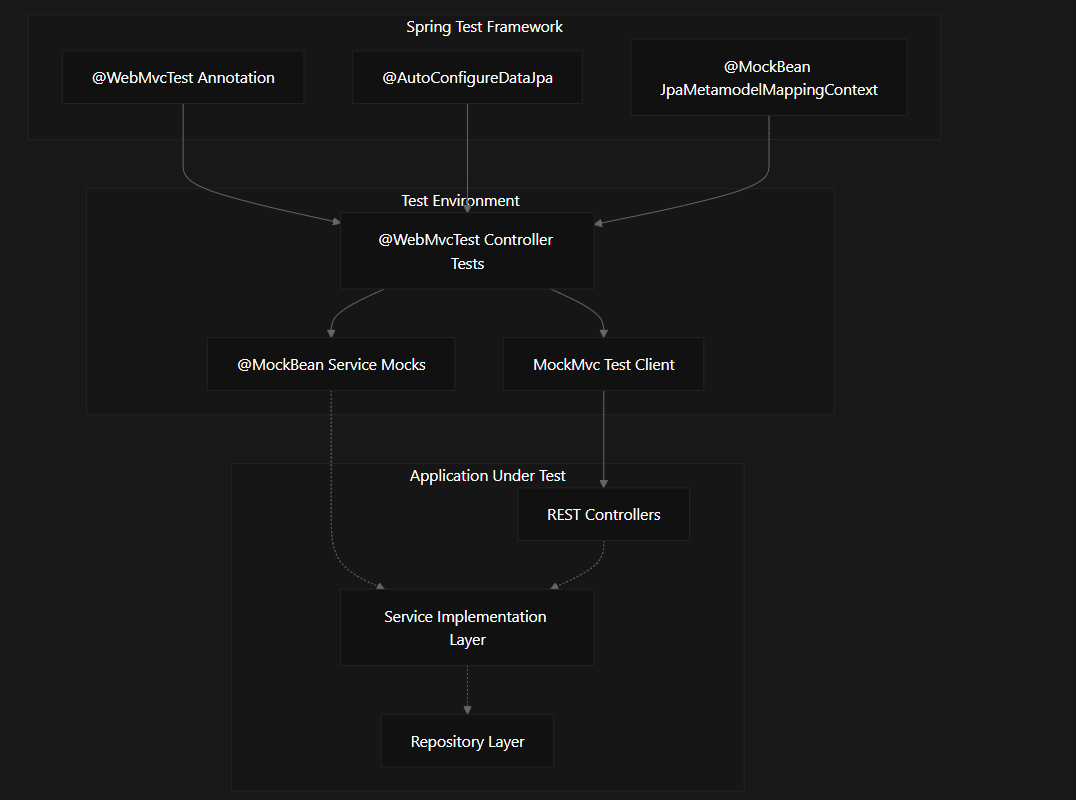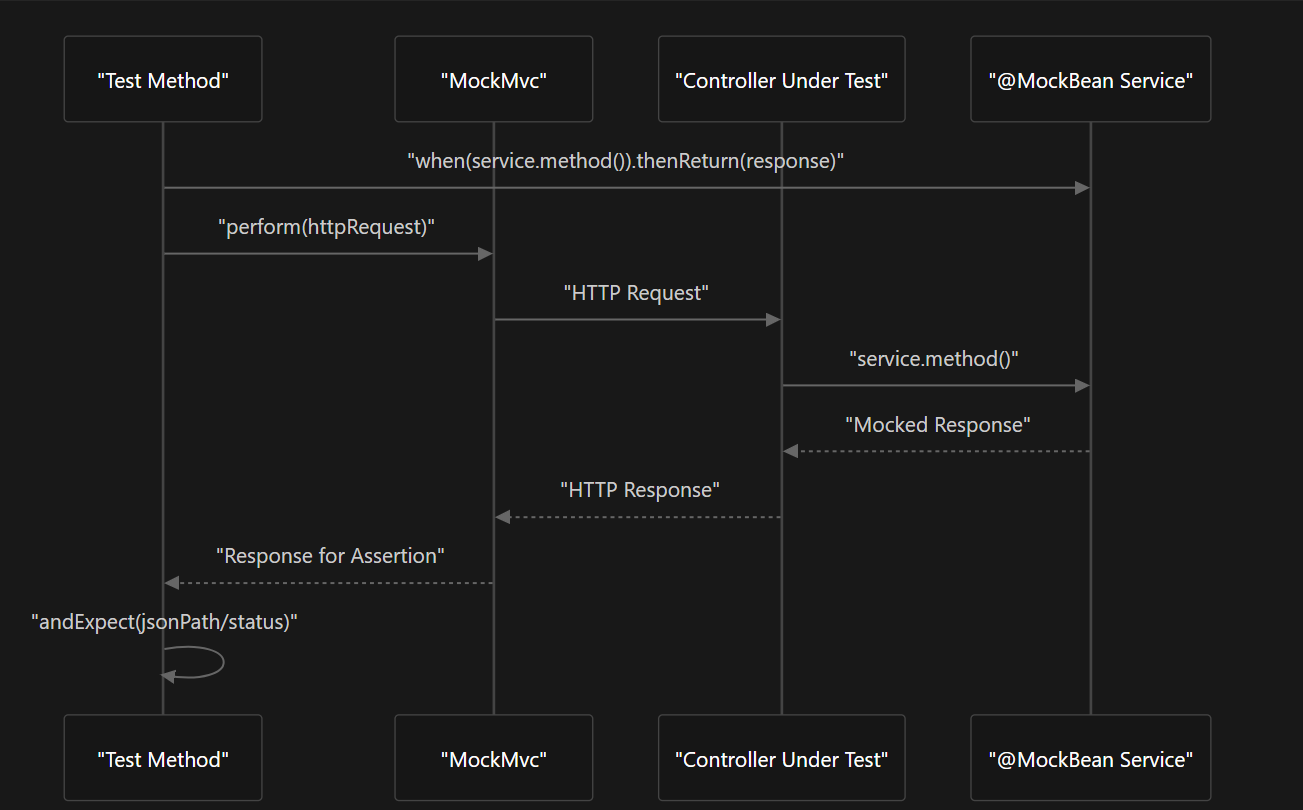Testing Framework
A comprehensive testing framework for the Student Management System Spring Boot application, focusing on controller integration tests that validate REST API behavior and ensure proper enforcement of API contracts and validation rules.
🎯 Purpose and Scope
This testing framework implements backend testing for the Spring Boot application with emphasis on:
- Web layer integration testing with isolated controller validation
- REST API behavior verification through comprehensive test coverage
- Service layer mocking to ensure clean separation of concerns
- Input validation testing to verify data integrity rules
For information about the actual REST API controllers being tested, see REST API Layer.
For details about the service layer implementations that are mocked in these tests, see Core Business Services.
🏗️ Testing Architecture
The backend employs Spring Boot's testing framework with a focus on web layer integration testing. The architecture isolates the controller layer for testing while mocking all service dependencies.
Spring Test Framework Components

Test Flow Architecture

Validation Testing Flow

🧪 Controller Test Implementation
Test Class Structure
All controller tests follow a consistent structure using Spring Boot's web layer testing capabilities:
| Component | Purpose | Implementation |
|---|---|---|
@WebMvcTest | Configures Spring MVC test context | Targets specific controller class |
MockMvc | HTTP request testing client | Injected via @Autowired |
@MockBean | Service layer mocking | Mocks service implementations |
@AutoConfigureDataJpa | JPA configuration for data-dependent tests | Used in EmailDomainControllerTest |
Test Method Naming Convention
The test classes implement comprehensive CRUD operation testing with consistent naming:
shouldGetAll{Entity}()- Tests GET collection endpointsshouldGet{Entity}ById()- Tests GET single resource endpointsshouldAdd{Entity}()- Tests POST creation endpointsshouldUpdate{Entity}()- Tests PUT update endpointsshouldDelete{Entity}()- Tests DELETE endpoints
Example Test Class Structure
@WebMvcTest(EmailDomainController.class)
@MockBean(JpaMetamodelMappingContext.class)
class EmailDomainControllerTest {
@Autowired
private MockMvc mockMvc;
@MockBean
private EmailDomainServiceImpl service;
@Test
void shouldGetAllEmailDomains() throws Exception {
// Test implementation
}
}
🎭 Service Layer Mocking Strategy
Mock Configuration
Each test class mocks its corresponding service implementation using @MockBean:
| Controller | Mocked Service | Mock Bean Declaration |
|---|---|---|
EmailDomainController | EmailDomainServiceImpl | @MockBean EmailDomainServiceImpl service |
FacultyController | FacultyServiceImpl | @MockBean FacultyServiceImpl facultyService |
ProgramController | ProgramServiceImpl | @MockBean ProgramServiceImpl programService |
StudentStatusController | StudentStatusServiceImpl | @MockBean StudentStatusServiceImpl studentStatusService |
Mock Behavior Setup
Tests use Mockito's when().thenReturn() pattern to define expected service behavior:
// Mock collection retrieval
when(service.getAllDomains()).thenReturn(emailDomains);
// Mock single entity retrieval
when(service.getDomainById(1)).thenReturn(emailDomain);
// Mock creation with argument matchers
when(service.createDomain(any(EmailDomainRequest.class))).thenReturn(emailDomain);
// Mock updates with specific ID matching
when(service.updateDomain(eq(1), any(EmailDomainRequest.class))).thenReturn(emailDomain);
✅ Request/Response Testing Pattern
HTTP Status and JSON Response Validation
The tests validate both HTTP status codes and JSON response structure using Spring's MockMvc assertions:
mockMvc.perform(get("/api/email-domains"))
.andExpect(status().isOk())
.andExpect(jsonPath("$.status").value(HttpStatus.OK.value()))
.andExpect(jsonPath("$.data.length()").value(expectedCount))
.andExpect(jsonPath("$.data[0].domain").value("example.com"));
Common Assertion Patterns
.andExpect(jsonPath("$.status").value(HttpStatus.OK.value()))- Status validation.andExpect(jsonPath("$.data.length()").value(expectedCount))- Collection size validation.andExpect(jsonPath("$.data.fieldName").value("expectedValue"))- Field value validation
🛡️ Validation Testing
Input Validation Tests
The EmailDomainControllerTest includes comprehensive validation testing for domain format requirements:
| Test Method | Validation Rule | Expected Behavior |
|---|---|---|
shouldRejectDomainWithoutTLD() | Domain must have TLD | Returns 400 Bad Request |
shouldRejectDomainStartingWithHyphen() | Domain cannot start with hyphen | Returns 400 Bad Request |
shouldRejectBlankDomain() | Domain cannot be blank | Returns 400 Bad Request |
These tests verify that controller-level validation annotations and custom validators properly reject invalid input before reaching the service layer.
Validation Test Example
@Test
void shouldRejectDomainWithoutTLD() throws Exception {
mockMvc.perform(post("/api/email-domains")
.contentType(MediaType.APPLICATION_JSON)
.content("{\"domain\": \"invalid-domain\"}"))
.andExpect(status().isBadRequest())
.andExpect(jsonPath("$.status").value(HttpStatus.BAD_REQUEST.value()));
}
📝 Test Data and Response Builders
Response DTO Construction
Tests use builder patterns to construct response DTOs for mocking:
// EmailDomain response
EmailDomainResponse.builder()
.id(1)
.domain("example.com")
.build();
// Faculty response
FacultyResponse.builder()
.id(1)
.facultyName("Computer Science")
.build();
// Program response
ProgramResponse.builder()
.id(1)
.programName("Computer Science")
.build();
// StudentStatus response
StudentStatusResponse.builder()
.id(1)
.studentStatusName("Active")
.build();
JSON Request Payloads
HTTP requests use inline JSON strings for request bodies:
// EmailDomain creation/update
"{\"domain\": \"example.com\"}"
// Faculty operations
"{\"facultyName\": \"Computer Science\"}"
// Program operations
"{\"programName\": \"Computer Science\"}"
// StudentStatus operations
"{\"studentStatusName\": \"Active\"}"
⚙️ Test Configuration Annotations
JPA Metamodel Handling
Most controller tests include @MockBean(JpaMetamodelMappingContext.class) to prevent Spring from attempting to load JPA metamodel during web layer testing, since the service layer is mocked and no actual database operations occur.
The EmailDomainControllerTest uses @AutoConfigureDataJpa instead, suggesting it may have some data-dependent validation logic that requires JPA configuration.
Web Layer Isolation
The @WebMvcTest annotation ensures that only web layer components are loaded, providing:
- Fast test execution by avoiding full application context loading
- Isolation of controller logic from service and repository layers
- Automatic configuration of MockMvc for HTTP testing
🚀 Running Tests
Prerequisites
- Java 11+
- Maven 3.6+
- Spring Boot 2.7+
Execute Tests
# Run all controller tests
mvn test -Dtest="*ControllerTest"
# Run specific controller test
mvn test -Dtest="EmailDomainControllerTest"
# Run with coverage report
mvn test jacoco:report
Test Categories
# Web layer tests only
mvn test -Dgroups="web-layer"
# Validation tests
mvn test -Dtest="*ControllerTest" -Dtest.validation=true
# Integration tests
mvn test -Dtest="*IntegrationTest"
📊 Test Coverage
The testing framework covers:
- ✅ HTTP Methods: GET, POST, PUT, DELETE
- ✅ Status Codes: 200, 201, 400, 404, 500
- ✅ Request Validation: Input format, required fields, constraints
- ✅ Response Structure: JSON format, field mapping, status codes
- ✅ Error Handling: Validation errors, service exceptions
- ✅ CRUD Operations: Complete lifecycle testing
🤝 Contributing
When adding new controller tests:
- Follow the established naming conventions
- Use
@WebMvcTestfor web layer isolation - Mock all service dependencies with
@MockBean - Include comprehensive validation testing
- Test all CRUD operations and error scenarios
- Maintain consistent assertion patterns
📄 File Structure
src/test/java/org/example/backend/controller/
├── EmailDomainControllerTest.java
├── FacultyControllerTest.java
├── ProgramControllerTest.java
├── StudentStatusControllerTest.java
└── [Other controller tests...]
🖼️ Testing Result
